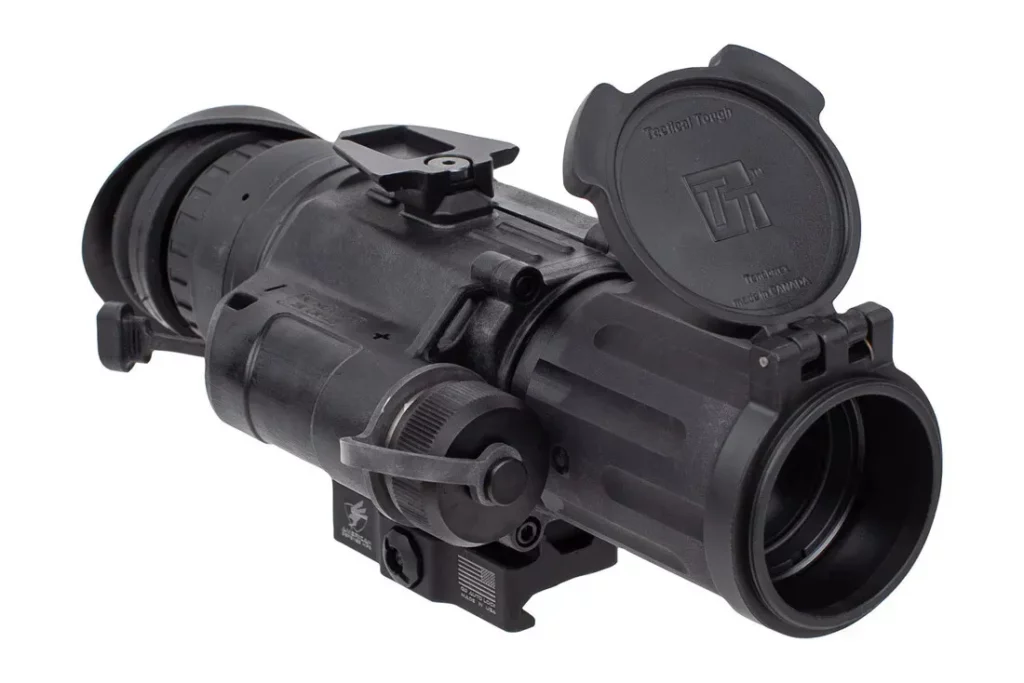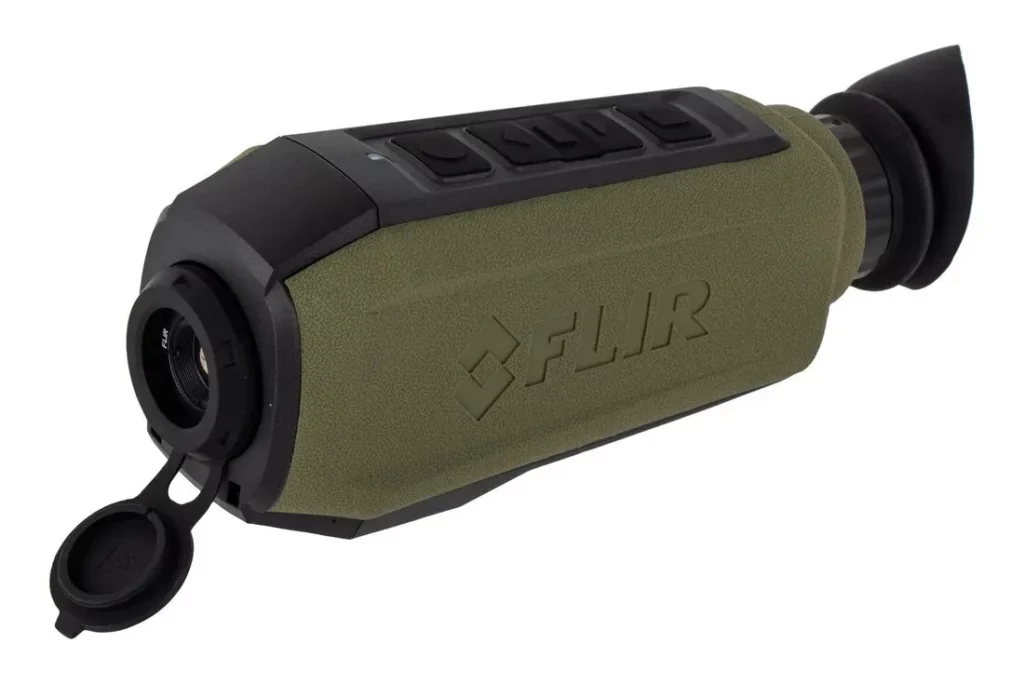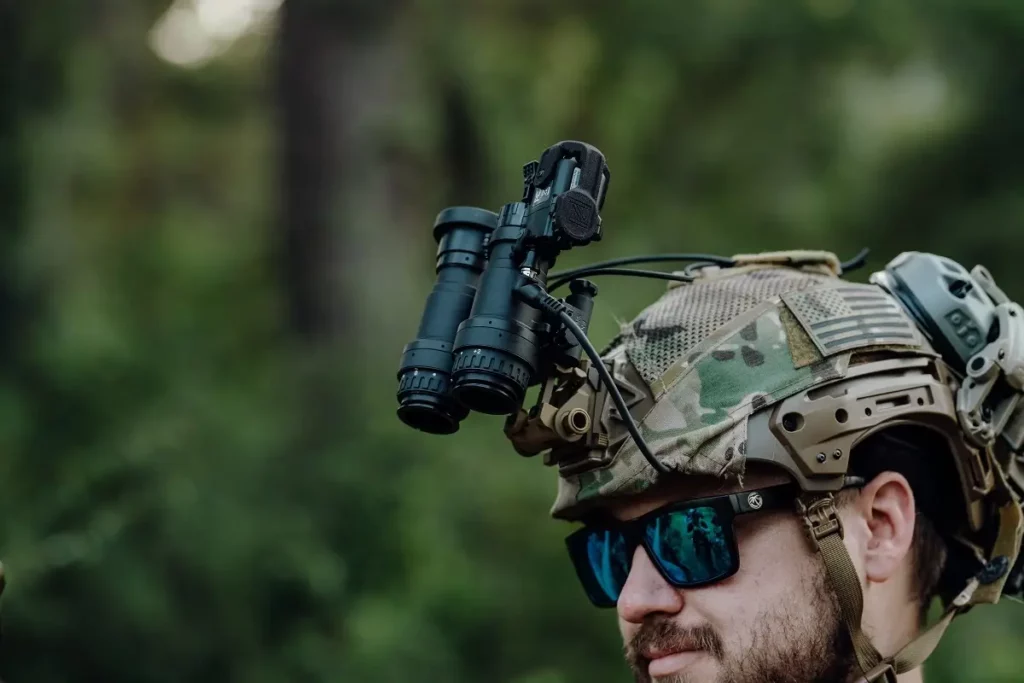Thermal imaging technology is the cutting edge of advanced optical aiming systems. What was once the domain of science fiction is now available, portable, and in some cases, downright affordable.
While thermal optics aren’t the right fit for every scenario and certainly won’t replace conventional scopes and red dots, they do what they do better than anything else on the market. When it comes to spotting threats or game through darkness, camouflage, or obscuring factors, there’s simply no substitute.

Thermal Optics: How They Work & How They’re Used
If you’re at all familiar with night vision optics, you know that they work by detecting light that we cannot see and using it to create an image that we can see. The way a thermal optic works is not dissimilar. While night vision optics can detect both visible and near-infrared light, thermal optics use specialized detectors to pick up a different spectrum of infrared light.
Shop All In-Stock Night Vision DevicesBuy Now
We won’t bore you with the physics lecture, so here’s the essence of it: everything with any amount of heat emits infrared light. The more heat, the more light. Thermal optics detect the light being emitted by everything within their field of view, feed it into a tiny onboard computer, and generate a visible image. The image created is color-coded according to relative heat.
The nature of the color-coding system will vary, but the most common configurations are white-hot and black-hot. The name refers to the color used to indicate higher concentrations of heat—in a black-hot system, for example, the darker an object appears, the hotter it is. In this system, cooler objects are usually rendered in white to provide contrast.
As the technology matures, newer and more sophisticated color palettes and configurations are becoming available, but they all boil down to basically the same thing; an image that lets you immediately spot sources of heat.
The value of this technology for police and military applications is obvious. Thermal imaging defeats most camouflage, lighting, or weather conditions, allowing soldiers to spot enemy combatants through smoke, dust, foliage, or the dark of night. While police sometimes use it to detect suspects, it’s also commonly used in search and rescue missions.

Types of Thermal Optics
Thermal optics come in a wide range of different configurations, ranging from small handheld devices to aerospace and nautical systems, but we’ll focus on man-portable systems.
The two biggest categories are weapon-mounted and handheld. Weapon-mounted thermal optics differ considerably from their handheld counterparts, not just due to their mount integration and recoil resistance but also in the feature set. These features may include reticles, recoil-activated recording, and sometimes even integrated rangefinders or ballistic calculators.
Weapon-mounted thermal optics can be further divided into two subcategories: magnified and unmagnified.
Magnified optics are the most common form of weapon-mounted thermals. The additional magnification offers the same advantages for hunting or pest control as a traditional scope, such as a more precise sight picture and a more detailed view of the target. This does come at the cost of field of view, though.
Shop All Thermal OpticsBuy Now
Unmagnified weapon-mounted optics are available but are not very common. Even without magnification, a thermal weapon-mounted optic is going to add significant weight to your firearm. At a minimum, a thermal optic requires a thermal detector apparatus, a screen, a battery, and a small computer. All that adds up, so current thermal technology won’t be as lightweight as a simple red dot, even if they are both unmagnified.
In addition to the weight, thermal optics inherently have a limited field of view, negating one of the primary advantages of unmagnified optics like red dots. For these reasons, unmagnified weapon-mounted thermal devices are not commonly fielded, except as clip-on devices used in conjunction with a traditional scope.
Handheld thermal optics, on the other hand, are rarely magnified. Handheld optics are commonly used as a surveillance tool to scan an area and detect anything that may be occupying it. They’re common hunting tools, especially for pests and invasive or destructive species like wild boar.
Often, handheld thermal devices are used in conjunction with night-vision or traditional optics for maximum efficiency when hunting.
Lastly, there are thermal optics that are neither weapon-mounted nor handheld. These thermal devices are mounted to a helmet or skullcrusher and are often used in conjunction with night vision devices.
Some units, such as Teledyne’s FLIR Breach device, offer standalone thermal imaging with sophisticated color palettes and a highly detailed view of the thermal signature of your field of view. This device can be used as a handheld or helmet-mounted. However, if you choose helmet-mount, these take the place of night vision, making you choose between thermal or night vision rather than use them simultaneously.
Others, like the AN/PAS29B ECOTI, integrate with night vision devices to provide a thermal overlay on top of the existing night vision image. This allows users to see in the dark while still highlighting abnormal thermal signatures.

Best Applications
We’ve already mentioned some of the most common uses of thermal devices for military and law enforcement entities, but they can be valuable for many civilian applications, too.
The most common civilian use for thermal optics is hunting. Whether you’re harvesting a deer to fill the freezer this winter or thinning out coyotes to keep them away from your chickens, a thermal optic is a massive advantage. Every animal is adapted to its environment and has natural camouflage to blend in with its surroundings. Thermal optics bypass this camouflage entirely. Regardless of how well your prey blends into the backdrop, it’ll be clearly visible on your screen.
Thermal vision also helps to detect heat behind a screen of vegetation, which is one of the reasons it’s so valuable to first responders during search and rescue missions. It’s easy to miss a person—or an animal, for hunters—if they’re partially or mostly covered by branches and leaves. With thermal imaging, even though the subject is mostly concealed, any parts that are exposed will still be highly visible, since they’ll be quite a bit warmer than the obscuring material
Lastly, thermal vision can be a huge advantage when hunting with night vision optics. Night vision is very effective at helping users see through the darkness, but even when aided by an infrared illuminator, it can be difficult to locate animals or camouflaged subjects, especially at longer ranges or under time constraints. Thermal is fast, effective, and simple. If it’s warm, thermal will make it visible.
Shop All Primary Arms Rifle ScopesBuy Now
The drawback to thermal optics for hunting is that they don’t often offer a great deal of detail on the subject being observed beyond their general shape. As such, it can be difficult to tell if the animal you’re looking at is actually a coyote or a dog. Augmenting thermal optics with a conventional scope for daytime use or night vision optics for nocturnal activities allows users to have the best of both worlds; thermal vision to detect potential targets, then a secondary sighting system to provide more detail and line up a shot.
Beyond hunting, thermal optics are in use around the country for general surveillance and monitoring of large tracts of land. When it comes to keeping an eye on your cows at night or making sure that the noise in the woods isn’t a hungry bear, there’s simply nothing that beats thermal imaging.

Thermal Optics: Buyer’s Guide
Whether you’re opting for a small handheld unit or a high-powered thermal scope, there are a few key features you’ll want to be aware of before making a purchase.
Detector Resolution
The largest determinant in the quality and detail of the image generated is going to be the thermal detector resolution. Naturally, higher-resolution detectors cost more, so you’ll want to consider your budget and how much detail you need when evaluating your purchase.
If you plan to use a handheld device to spot game, then a night vision scope to take it down, you probably don’t need an ultra-high-resolution thermal detector and can get away with a cheaper unit. On the other hand, if you plan to use a thermal scope as your sole aiming system, a more detailed image is going to be essential for target identification.
Screen Resolution
Of course, thermal detector resolution isn’t the only thing that affects image clarity—the resolution of the screen will play a big part as well. As with TVs, computer monitors, and cell phones, the resolution of the screen is measured in pixels, with higher numbers indicating a clearer and more detailed picture.
As with thermal detector resolution, consider how much image detail you need and how much you are willing to pay.
Refresh Rate
Refresh rate is a measure of how many times per second the image on the screen is replaced with a fresh one created from input into the thermal detector. The higher the refresh rate, the more images are created per second.
Refresh rate can have a big impact on hunting performance. A higher refresh rate creates a “smoother” impression of the image and provides a more accurate image of targets on the move. Thermal optics with low refresh rates can be difficult to use with moving targets, so they’re best suited for general observation rather than hunting or tactical use.
Weight
If you’re going to be carry your rifle through the woods, whether on a sling or in your hands, weight matters. More weight means more fatigue and less comfort. After a couple of hours of both, you may find your muscles tired when it comes time to take the shot, which isn’t going to do anything to help your accuracy.
All thermal optics will be relatively heavy compared to traditional rifle scopes, but some are heavier than others. If your hunting is primarily done from a blind you drive to, you can get away with a cheaper, heavier scope. If you plan to backpack to your hunting location, though, you may want to consider spending a bit more for a lighter model. As always, your use case will determine just how important this criterion is.
Battery Life
Thermal devices are a type of electro-optic, and as such, they’re only any good as long as they have electricity to power them. Once your battery dies, you have nothing more than an expensive paperweight until you can charge it again.
Battery life varies considerably across different models. Many of the smaller handheld or head-mounted units use standard removable batteries like AAs or CR123s. Larger weapon-mounted or handheld units can have either removable or built-in rechargeable batteries.
Shop All Thermal OpticsBuy Now
For devices with replaceable batteries, battery life is less important. If all it takes to get your optic back into action is dumping out the old batteries and popping in fresh ones, you can probably get away with a device with shorter overall life and compensate for it by adding a few spares to your pack.
On the other hand, battery life is crucial in devices that require recharging. If the only way to bring your optic back online is to take it back to your house and plug it in, then it must be capable of continuous operation long enough to complete your hunt or patrol.

Summary
Thermal optics aren’t for everyone, nor are they appropriate for every application. They are, though, the single most effective tool for what they do.
They can defeat any camouflage and nearly any cover or concealment. Thermal imaging sees through smoke, darkness, or fog, offering valuable information when conventional optics fall short. When you absolutely need to know what’s out there, you need thermal.



